This exam is conducted all across the country every year for admission into several campuses of the institute. As there are limited seats and the competition is quite intense, it is important that you prepare in a thorough and smart manner. You will be able to do this easily by attempting the NIFT mock test on the leading educational platform of SelfStudys. This practice will allow you to check your current level of preparation, improve your speed and accuracy, as well as get familiar with the real exam pattern.
The NIFT mock test 2026 is designed by our team of experts by keeping the latest syllabus and exam structure in mind. You can access this high-quality study material and practice it anytime, anywhere completely free on our website. All you need is a device and an internet connection. Regular attempts at the tests will surely maximize your chances of success in the actual examination.
Tentative Schedule For The Upcoming National Institute of Fashion Technology Entrance Examination
In the table below, we have described a tentative schedule for the dates related to the upcoming National Institute of Fashion Technology Entrance Exam. You should go through it to prepare accordingly for the exam.
| ACTIVITY | TENTATIVE DATES |
|---|---|
|
Online registration and submission of Application Form |
November 2025 to January 2026 |
|
Last date for submission of application with late fees of INR 5000 |
January 2026 |
|
Correction in the Particulars of Application Form online only |
January 2026 |
|
Date of Examination Schedule |
February 2026 |
Scheme Of The NIFT Examination
For your reference, we have given the details related to the scheme of this examination. You should check out the table below to understand this exam clearly.
| PARTICULARS | DETAILS | ||
|---|---|---|---|
|
Mode of the Examination |
|
||
|
Pattern of the Question Paper |
Program |
Exam Components |
Shortlisting Criteria |
|
B.Des- Bachelor of Design |
General Ability Test (GAT), Creative Ability Test (CAT) |
Based on the entrance examination, followed by a Situation Test. |
|
|
B.F.Tech.- Bachelor of Fashion Technology |
General Ability Test (GAT) |
Based on the GAT. |
|
|
M.Des.- Master of Design |
General Ability Test (GAT), Creative Ability Test (CAT) |
Based on GAT + CAT, followed by a Personal Interview (PI). |
|
|
M.F.M- Master of Fashion Management |
General Ability Test (GAT) |
Based on the GAT, followed by a Personal Interview (PI). |
|
|
M.F.Tech.- Master of Fashion Technology |
General Ability Test (GAT) |
Based on the GAT, followed by a Personal Interview (PI). |
|
|
Ph.D |
Written test |
Research Proposal Presentation and Interview (RPPI). |
|
|
Medium of the Examination |
GAT is conducted in Hindi and English. |
||
|
Sections in the General Ability Test |
5 sections in total
|
||
|
Number of Questions in the General Ability Test |
|
||
|
Duration of the General Ability Test |
|
||
|
Marking Scheme of the Examination |
|
||
Section-Wise NIFT MockTest 2026 Available
In order to help you in mastering every section of the examination, we offer the free NIFT mock test in a section-wise format. You can explore these resources and attempt any one of them as per your study plan. Through this practice, you can check the areas where your knowledge is strong or weak. Then, you can prioritize your sessions on the topics where you still need to improve. There are also direct links given here for these tests for ease of use.
Accurate Solutions Given In The Free NIFT Mock Test
After completing the questions in the NIFT online mock test, you should access their solutions on our platform. They also have detailed explanations with which you can understand the reasoning behind the answer. These solutions are 100% correct as they are prepared by our team of subject-matter experts. By cross-checking your responses, you can measure your performance level and make any required changes to your strategies.
Eligibility Criteria For The NIFT Examination
In this section, we have given the details about the eligibility criteria that you must fulfill for admission into undergraduate programs through the National Institute of Fashion Technology Entrance Exam.
Upper Age Limit: The maximum age for the bachelor's program (B.Des. and B.F.Tech) should be under 24 years as of 1st August of the admission year. You will get 5 years of age relaxation if you belong to the Scheduled Caste/Scheduled Tribe/ Person with Disability (PwD) categories.
Educational Qualification:
The table below explains the educational qualifications for the UG programs.
| PROGRAM | ELIGIBILITY CRITERIA |
|---|---|
|
Bachelor of Design (B.Des.) |
Successfully completed the plus 2 level examination in the 10+2 format from any accredited Central or State Board of Secondary Education, including the Central Board of Secondary Education, State Board New Delhi, or the Council for Indian School Certificate Examination, New Delhi. OR A passing grade in the Senior Secondary School Examination administered by the National Open School, encompassing at least five topics. OR A 3 or 4-year diploma accredited by AICTE or a State Board of Technical Education following the completion of secondary education/10th standard. OR Any public school, board, or university examination in India or abroad that is recognized by the Association of Indian Universities as equivalent to the 10+2 system. OR General Certificate of Education (GCE) Examination (London/Cambridge/Sri Lanka) at the Advanced (A) level/International Baccalaureate (IB). |
|
Bachelor of Fashion Technology (B.F.Tech) |
Passed the 10+2 plus 2 level exam from any approved Central or State Board of Secondary Examination, including the Council for Indian School Certificate Examination, New Delhi with Mathematics, or the Central Board of Secondary Education, New Delhi. OR A passing score in at least five subjects along with mathematics in the National Open School's Senior Secondary School Examination. OR Following a secondary exam or 10th grade, students can pursue a three or four-year diploma in any engineering field approved by the AICTE or a State Board of Technical Education. OR Any public school, board, or university exam that is recognized by the Association of Indian Universities as being comparable to the 10+2 system with mathematics, whether it is administered in India or abroad. |
Process That Needs To Be Completed To Attempt The NIFT Online Mock Test On Our Website
At our educational platform, you just need to follow a few easy steps to attempt the NIFT free mock test. Just make sure your device has a stable internet connection for successful attempts.
- Reaching our website requires typing in www.selfstudys.com on a browser.

- The first click is to be on the ‘Navigation’ tab as it will help you to check out our main menu.
- In this menu, you should scroll down a bit and select the ‘UG’ section.
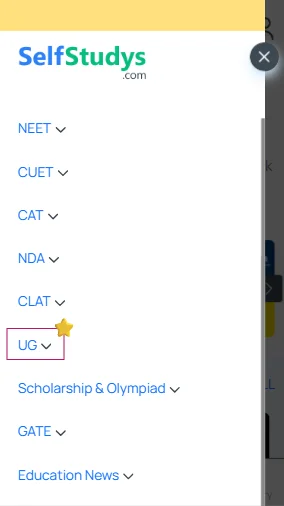
- Now, you will see a new drop-down menu from where you have to click on the ‘NIFT mock test’ icon.
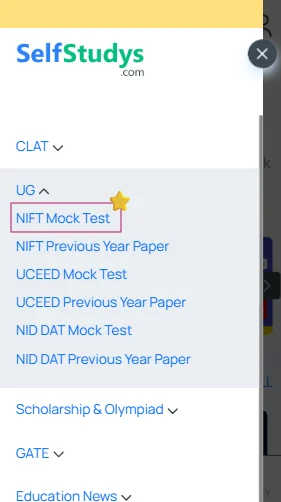
- Then, you can go through the section-wise NIFT free online mock test and click on any.

- At last, you just need to tap on the ‘Start Test’ icon of your chosen mock test series for NIFT and begin solving the questions.
Note: The result of your attempt at the NIFT mock test 2026 will only be generated after you Log In or Sign Up on the platform. This can be done easily with your Google account.
Why NIFT Free Mock Test Is Important For Aspirants?
With the free NIFT mock test attempts, you can get one step closer to understanding the real value of this resource during your exam preparation. We have also described some of the related points in detail below.
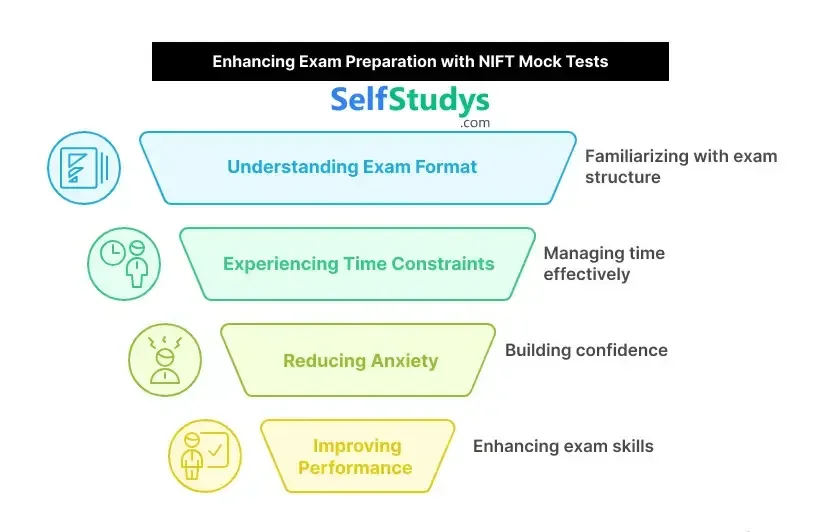
- In the NIFT online mock test, you will see the replication of the actual exam format, time constraints, as well as question patterns. This structure will help you experience the pressure and pace of the real exam, reduce your anxiety, and improve your performance on the examination day.
- One key challenge faced by many aspirants is to balance complex and analytical questions. Through the practice of the NIFT free mock test, you will be able to learn how to allocate your time across the sections in an effective way. It will also increase your speed without compromising on accuracy.
- When you attempt the NIFT free online mock test on a regular basis, you can easily find the sections in which you excel and the ones that need more attention. In this way, you can have more focused as well as personalized study planning.
- Our mock test series for NIFT is designed as per the latest syllabus and exam pattern that is released by the authorities. This way, we keep you updated on any changes in the question trends and help you understand how different topics are weighted in the examination.
- By exposing yourself to the NIFT mock test repeatedly, you can reduce your fear of the unknown. Familiarization with the format will lead to calmness and mental clarity during the real exam. This is what makes the difference between a good and great performance.
Syllabus Of The National Institute of Fashion Technology Exam For UG Programs
As there are different components involved in the NIFT exam, we have all of these components below.
General Ability Test
The below syllabus is for all the UG and PG programs.
| SECTION | TOPICS |
|---|---|
|
English Comprehension: This section tests your reading and understanding skills. These are quite essential for understanding briefs, design concepts, and communication in the fashion industry. |
Reading Comprehension
|
|
Theme and Central Idea
|
|
|
Inference and Conclusion
|
|
|
Tone and Mood
|
|
|
Vocabulary in Context
|
|
|
Paraphrasing
|
|
|
Fact vs. Opinion
|
|
|
Summarization
|
|
|
Communication Ability: This section evaluates your vocabulary, grammar, and language usage that are important for fashion communication, marketing, and branding. |
Vocabulary Building
|
|
Grammar
|
|
|
Idioms and Phrases
|
|
|
One-word Substitution
|
|
|
Sentence Correction
|
|
|
Sentence Completion
|
|
|
Word Formation
|
|
|
Cloze Test
|
|
|
Error Spotting
|
|
|
Foreign Words in English
|
|
|
Quantitative Ability: This section tests your numerical computation and problem-solving abilities. It’s not just about math. It is about how you apply basic mathematical concepts to real-world problems. |
Number Systems
|
|
Arithmetic Operations
|
|
|
Percentages
|
|
|
Ratio and Proportion
|
|
|
Simple and Compound Interest
|
|
|
Time, Speed, and Distance
|
|
|
Time and Work
|
|
|
Averages and Mixtures
|
|
|
Algebra
|
|
|
Mensuration
|
|
|
Geometry
|
|
|
Data Interpretation
|
|
|
Permutation and Combination
|
|
|
Probability
|
|
|
Analytical Ability: This section assesses your ability to solve logic-based problems. These are critical for design thinking and problem-solving in creative fields. |
Coding-Decoding
|
|
Series
|
|
|
Analogies
|
|
|
Blood Relations
|
|
|
Direction Sense Test
|
|
|
Order and Ranking
|
|
|
Venn Diagrams
|
|
|
Syllogisms
|
|
|
Cubes and Dice
|
|
|
Puzzle Tests
|
|
|
Seating Arrangements
|
|
|
Data Sufficiency
|
|
|
Calendar and Clock Problems
|
|
|
Mathematical Operations
|
|
|
General Knowledge and Current Affairs: This section tests your awareness of national and international events, especially those related to fashion, lifestyle, economy, and design. |
Fashion and Textile Industry
|
|
Current Events
|
|
|
Awards and Honours
|
|
|
Art and Culture
|
|
|
Sports
|
|
|
Books and Authors
|
|
|
Geography
|
|
|
History
|
|
|
Economy and Finance
|
|
|
Science and Technology
|
|
|
International Organizations
|
|
|
Important Dates and Days
|
|
|
Famous Personalities
|
|
|
Design & Architecture
|
|
|
Case Study: This section has realistic scenarios that involve business operations, fashion retail, merchandising, design thinking, production management, sustainability, marketing, and supply chain. |
Retail and Fashion Business Scenarios
|
|
Marketing and Branding
|
|
|
Operations and Supply Chain Management
|
|
|
Human Resource and Organizational Behavior
|
|
|
Finance and Business Analytics
|
|
|
Sustainability and Ethical Practices
|
|
|
Technology and Innovation
|
|
|
Consumer Experience and Strategy
|
Creative Ability Test
This test is administered for both UG and PG Design Programmes to judge your intuitive ability, power of observation, concept development, and design ability. An important aspect of the test is the creative and innovative use of color and illustration skills. In case you try to disclose your identity by writing any personal details or placing any identification mark on the answer sheet, then you shall be ‘Disqualified’ and your result will not be declared. The decision of NIFT on such cases will be final and there will be no appeal.
Situation Test
This test is conducted for the UG Design programs.
- Once you are shortlisted from the written entrance examination, you will be required to take the Situation test. It is a hands-on test to evaluate your skills for material handling as well as innovative ability in a given situation with a given set of materials. You will not be provided or allowed any additional material.
- The model will be evaluated on space visualization, innovative and creative use of given material, the composition of elements, color scheme, construction skill, the finesse of the model, overall presentation, etc. These parameters will be checked with the write-up explaining the concept behind the model constructed. Since the medium of instruction in NIFT is English, the write-up will be in English. No marks will be given for write-ups in any other language.
- The evaluation of the test will be done by the Jury on the spot. The model will not be preserved for future reference. NIFT reserves the right to modify the entrance Examination Scheme, including non-conduct of any stage(s) due to unforeseen circumstances.
Group Discussion
This is for all PG programs. If you are shortlisted for the Master's Program from the written entrance examination, then you are required to undergo Case Study-based Group Discussions. It would comprise approximately 15 to 20 minutes of discussion on a case study assigned, on which a panel of experts will assess you on various parameter,s including:
- Conceptual clarity
- Knowledge of the topic assigned
- Contribution made to the topic
- Interpersonal skills
- Ability to generate new ideas
- Problem-solving approach
- Leadership qualities
- Effective communication
Personal Interview
After the Group Discussion, you will be evaluated in the Personal Interview by a panel on various parameters as follows:
- Career orientation
- Aptness for the course
- Overall personal achievements in academics and co-curricular activities
- Communication
- General awareness and aptitude, creative, as well as lateral thinking.
Tips To Maximize Your NIFT Free Online Mock Test Performance
In order to truly benefit yourself with the NIFT mock test 2026, you need to know how to use it as a powerful learning tool. Here, we have given some innovative tips that you can utilize to enhance your performance in the mock tests.
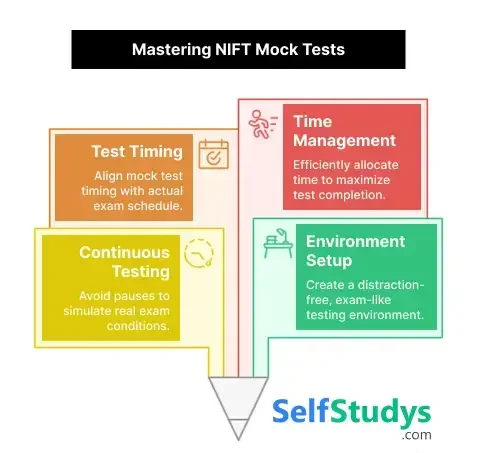
- You should set up the environment of the free NIFT mock test just like the real exam, without any distractions. Also, you need to take the test at the same time of day as your actual exam. This will sync the peak performance period of your brain. You should avoid pausing the test in between, as it will not be allowed in the real test.
- While solving the NIFT online mock test, it is necessary that you focus on speed as well as accuracy. You can also use these NIFT previous year papers to develop shortcuts for the quant section, learn to skim read for English, practice visualization for analytical reasoning, and so on.
- After every attempt at the NIFT free mock test, you should maintain a mistake journal. In this, you can separate the mistakes by the sections and note down why they happened (concept gap, time pressure, misreading, etc.). Then, you should review the journal on a weekly basis to spot any patterns and avoid repetition of the mistakes.
- Moreover, you can create a spreadsheet to track your score in each section, time spent per question, accuracy rate, attempt rate, and so on. After this, you should use this data to adjust your startegy for the next NIFT free online mock test.
- The National Institute of Fashion Technology Entrance Exam is quite long and drains a candidate mentally. But with the mock test series for NIFT, you will be able to build your stamina in concentration. For this, you can use techniques like Pomodoro for daily practice, Eye-rest exercises during the test, eat a light meal before mocks, similar to what you’ll eat on test day, etc.
Campuses Of The National Institute Of Fashion Technology And Offered Courses
There are around 19 NIFT campuses all around the country where you can complete your undergraduate course. In the table below, we have given the details about these campuses as well as the specializations that they offer.
| CAMPUS CENTER AND YEAR OF ESTABLISHMENT | COURSES OFFERED |
|---|---|
|
National Institute of Fashion Technology, New Delhi, 1986 |
|
|
National Institute of Fashion Technology, Chennai, 1995 |
|
|
National Institute of Fashion Technology, Gandhinagar, 1995 |
|
|
National Institute of Fashion Technology, Hyderabad, 1995 |
|
|
National Institute of Fashion Technology, Kolkata, 1995 |
|
|
National Institute of Fashion Technology, Mumbai, 1995 |
|
|
National Institute of Fashion Technology, Bengaluru, 1996 |
|
|
National Institute of Fashion Technology, Raebareli, 2007 |
|
|
National Institute of Fashion Technology, Bhopal, 2008 |
|
|
National Institute of Fashion Technology, Kannur, 2008 |
|
|
National Institute of Fashion Technology, Shillong, 2008 |
|
|
National Institute of Fashion Technology, Patna, 2008 |
|
|
National Institute of Fashion Technology, Kangra, 2009 |
|
|
National Institute of Fashion Technology, Bhubaneswar, 2010 |
|
|
National Institute of Fashion Technology, Jodhpur, 2010 |
|
|
National Institute of Fashion Technology, Srinagar, 2013 |
|
|
National Institute of Fashion Technology, Panchkula, 2019 |
|
|
National Institute of Fashion Technology, Daman, 2022 |
|
|
National Institute of Fashion Technology, Varanasi, 2024 |
|
Registration Process For The National Institute of Fashion Technology Exam
We have displayed some images below that explains the registration process for the NIFT exam properly.
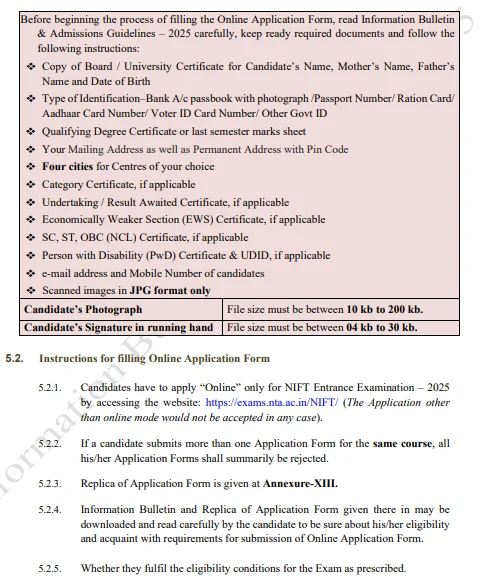
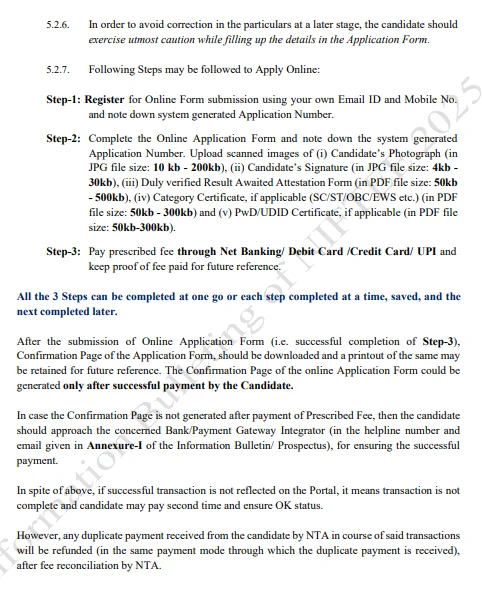
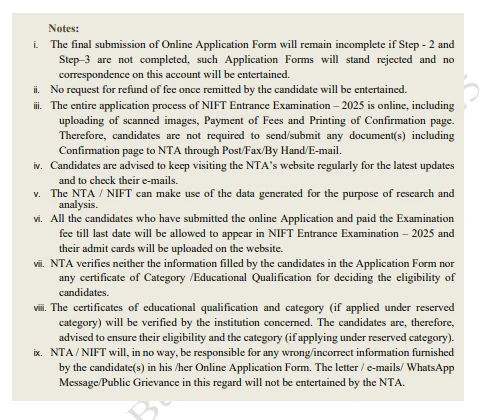
Places That Are The NIFT Entrance Exam Centers
Here is the list of all the cities where the National Institute of Fashion Technology Entrance Exam is conducted.
| STATE | CITIES |
|---|---|
|
Andaman & Nicobar Islands |
Port Blair |
|
Andhra Pradesh |
Kurnool, Vijayawada, Visakhapatnam, Rajahmundry, Tirupathi |
|
Arunachal Pradesh |
Naharlagun |
|
Assam |
Guwahati |
|
Bihar |
Muzaffarpur, Patna |
|
Chandigarh |
Chandigarh/Mohali |
|
Chhattisgarh |
Raipur, Jagdalpur |
|
Dadra & Nagar Haveli |
Silvassa |
|
Delhi |
Delhi NCR |
|
Goa |
Mapusa |
|
Gujarat |
Ahmedabad/ Gandhinagar, Rajkot, Surat, Anand, Gandhinagar, Mehsana |
|
Haryana |
Hisar, Kurukshetra |
|
Himachal Pradesh |
Bilaspur HP, Kangra |
|
Jammu And Kashmir |
Jammu, Srinagar |
|
Jharkhand |
Dhanbad, Ranchi |
|
Karnataka |
Bengaluru, Mysuru (Mysore), Mangalore (Mangalore) |
|
Kerala |
Ernakulam, Kannur, Kozhikode, Kollam, Kottayam, Thiruvananthapuram, Thrissur |
|
Ladakh |
Leh / Kargil |
|
Lakshadweep |
Kavaratti |
|
Madhya Pradesh |
Bhopal, Jabalpur, Gwalior, Satna, Ujjain |
|
Maharashtra |
Mumbai / Thane, Nagpur, Pune, Chhatrapati Sambhaji Nagar, Amravati, Kolhapur, Nanded |
|
Manipur |
Imphal |
|
Meghalaya |
Shillong |
|
Mizoram |
Aizawl |
|
Nagaland |
Kohima |
|
Odisha |
Berhampur-Ganjam, Bhubaneswar |
|
Puducherry |
Puducherry |
|
Punjab |
Ludhiana |
|
Rajasthan |
Jaipur, Jodhpur, Udaipur |
|
Sikkim |
Gangtok |
|
Tamil Nadu |
Chennai, Coimbatore, Madurai, Salem, Tiruchirappalli, Vellore |
|
Telangana |
Hyderabad |
|
Tripura |
Agartala |
|
Uttar Pradesh |
Meerut, Muzaffarnagar, Kanpur, Lucknow, Varanasi |
|
Uttarakhand |
Dehradun, Haldwani |
|
West Bengal |
Kolkata |
Conclusion
The NIFT mock test is a performance mirror tool that reveals where you stand and what you need to refine before the actual NIFT entrance exam. By using it wisely, you can master all the sections in an efficient as well as effective manner. Also, analysis of your mistakes, progress tracking, and replicating conditions of the real exam will not only improve your knowledge and speed but also build your confidence and test character. So, you should treat every mock test as a serious opportunity to grow, experiment, as well as evolve your strategy.







 Profile
Profile Signout
Signout










 Quiz
Quiz
 Get latest Exam Updates
Get latest Exam Updates 










